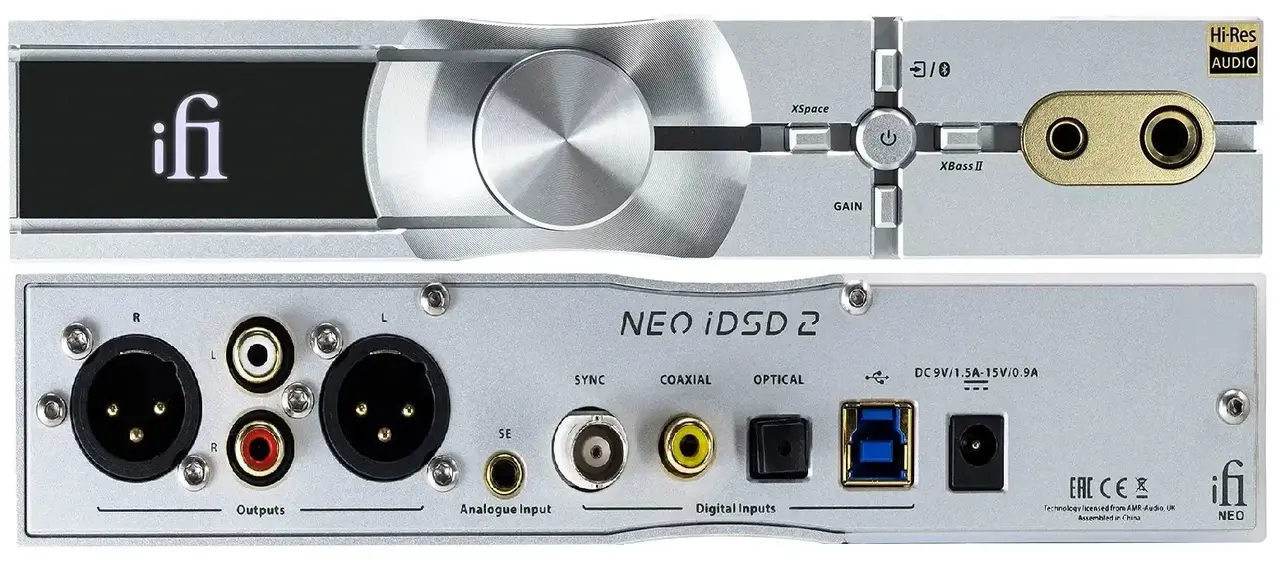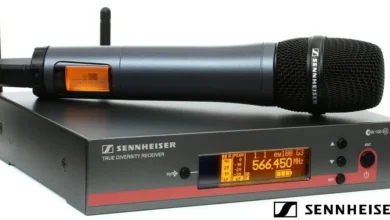

iFi NEO iDSD 2 DAC The new generation of devices from the line of desktop components from iFi develops the most interesting ideas of its predecessors
The iFi NEO iDSD 2 DAC headphone amplifier continues to develop the successful NEO series. Last year we published a review of the iFi network player NEO Stream, which received the EISA 2023-2024 award as the best streamer in Europe, and this well-deserved title encourages us to continue exploring the entire line under the NEO name.
The NEO iDSD 2 device will undoubtedly be an ideal partner for NEO Stream, although the proprietary
two-unit kit is far from the only possible scenario for its use. The DAC amplifier will easily fit into
any traditional stereo system or act as the main component, for example, in conjunction with a pair of headphones and a smartphone as a digital transport.
Layout and features of NEO iDSD 2
The design and form factor of NEO components are thought out to the smallest detail. The Panel’s width
is 21 cm is specially selected so that the DAC and streamer installed next to it correspond to the
dimensions of a standard audio component. Also included with iFi NEO devices are stands for vertical installation, and in this position the picture on the display rotates automatically. It is noteworthy that NEO iDSD 2 can also be used as a practical headphone stand, and this is very convenient in conjunction with a PC.
The functionality of the device is well-balanced. NEO iDSD 2 has coaxial, optical, and USB inputs, as well
as an analog connector, so you can simultaneously connect four signal sources with cables, for example,
a streamer, a TV, a CD player, and a vinyl player.
By air without loss
However, the most interesting and advanced connection method is hidden under the plastic corner of
the device, illuminated from the inside: this is a bidirectional Bluetooth module version 5.4, modified by iFi engineers together with Qualcomm. It supports Hi-Fi and HiRes codecs, including LDAC, LHDC/HWA, and – most importantly – aptX Lossless with a bitrate of 1200 kbps, which is actually capable of transmitting a signal in CD quality without loss. Moreover, the manufacturer claims that NEO iDSD 2 became the world’s first DAC amplifier for headphones, which implements this top codec of the aptX family.
In addition, in the modified chipset, the developers have implemented a high-quality SPDIF input for broadcasting a signal via Bluetooth from the digital part of the DAC to headphones or active speakers,
as well as a custom XMOS interface for outputting sound from the Bluetooth module to the DAC
(nothing like this in the standard Qualcomm chipset initially did not have). In other words, in conjunction with a smartphone that supports HiRes codecs, the device turns into a high-quality streamer capable of playing music without compression or loss of quality.
Another equally important function of NEO iDSD 2 is a headphone amplifier. Implemented
in the form of two circuits: an unbalanced amplifier with a 6.3 mm output produces 2.8 W at 32 Ohms, and a balanced amplifier with a 4.4 mm jack provides 5.5 W. This design, combined with a low output impedance (less than one ohm) and four stages of gain control ranging from -12 to +16 dB, ensures compatibility with virtually any headphone.
Line outputs will automatically disabled. When you connect headphones. And since you can connect
not only an amplifier in a stereo system but also active speakers standing near a computer, this
is very convenient for everyday use.
Inside Look of NEO iDSD 2
If you compare the output characteristics of the NEO iDSD 2 headphone amplifier and its previous
version, you can see a significant increase in power and better signal-to-noise ratio, because the developers borrowed the circuitry for the second version from the top-end portable DAC amplifier
for headphones iFi iDSD Diablo.
Among other things, the circuit includes Auto iEMatch technology, which reduces high-frequency noise when using low-impedance, highly sensitive ear monitors. What is important is that the noise reduction here is not accompanied by a loss of high frequencies or a narrowing of the dynamic range. For other headphone models, you can choose a higher or lower gain (gain) for better matching with the amplifier.
Two more technologies – X Bass and X Space – are implemented in the form of analog circuits. The volume control is also made analog. Four typical digital filter operating modes are available in the DAC settings.
All this variety is needed for the initial coordination of the device with the headphones connected to it.
X Bass technology
For example, X Bass technology has three modes that boost different parts of the frequency range to compensate for dips in the frequency response of different headphone models. X Space, in turn, will
be needed only by those whose headphones sound very crowded, with a narrow stage, and owners of
open models with a large-scale stereo image simply do not need its additional expansion.
The circuitry of the digital part is also not the simplest. USB and SPDIF inputs are served by a 16-core XMOS chipset with original firmware written by iFi specialists. A femtosecond precision clock generator controls the entire digital part, and advanced users can connect an external locker.
There is an MQA decoder on board, capable of fully decompressing the format. For digital-to-analog conversion, engineers used a multi-bit chip from Burr-Brown, which underlies the proprietary True Native circuit, which provides audio decoding in the native format without changing the bit depth and frequency.
As for components, in this regard, IFi is true to itself and uses components that it considers the best:
low-noise operational amplifiers from Texas Instruments, ceramic capacitors from TDK and Murata,
which minimizes losses and distortion of the useful signal. The developers implemented switching and mode switching using high-quality MOSFET elements, and not using relays, as is usually the case.
In short, the creators of NEO iDSD 2 put a lot of effort into ridding their brainchild of potential weak
points. The included proprietary power supply completes the picture. I have previously seen a noticeable positive effect from using iFi network adapters, and it was so noticeable that it literally increased the overall sound quality of the device by one notch.
Sound with and without improvements
The abundance of adjustments inevitably leads to the fact that before testing the device, you first have
to figure out in what mode the listening will take place. The X Bass tuning has three scenarios, marked in blue, green, and red.
Blue is responsible for enhancing the bass region and behaves quite predictably. Green adds what sound engineers call “presence” – this is no longer the bass range, but the upper midrange, a slight boost of which gives the effect of bringing the sound source closer to the listener, makes the sound more expressive and prominent, and the lack of presence makes it dull and distant from the listener. Red X Bass is both bass and presence at once.
If you take studio headphones with an initially linear frequency response, then pressing the “red button” will make the presentation bassy, colorful, and textured. In general, the effect of using different versions of X Bass depends entirely on the settings of the headphones, and this technology is not always worth using.
X Space works quite predictably, achieving a wide stage from closed headphones playing closely, comparable to open ones. At the same time, the tonal balance practically does not suffer, and the sound image remains well-focused.
In order to somehow identify the signature sound signature, as the main testing tool I used several headphones with the most balanced frequency response – with which there is no need to use sound enhancement technologies. I chose a balanced connection – it is more advantageous not only in terms
of output characteristics but also in terms of sound quality in general. In a direct comparison, I found the single-ended output to be a little simpler sounding.
Listening
I started listening to The Beatles, which is quite logical for testing the products of an English brand. From the first notes, NEO iDSD 2 pleased me with its combination of high resolution and richness of timbres, which you would not expect from a device of this price category and such dimensions. The signature polyphony and unusual melodic moves of the Beatles sounded very beautiful and expressive, once again making it clear why this particular group has become a source of inspiration for many groups and performers around the world.


Having moved from classic rock to classic jazz in its modern incarnations, I also noted an expressive and solid sound with a well-articulated midrange that conveys the intonations and timbres of the vocalists. The midrange is, in principle, one of the strongest points of the NEO iDSD 2. Closer to the listener, than the edges of the range, and this improves intelligibility, providing the effect of a more soulful intimate sound. You experience similar sensations at small club concerts when you stand near the stage and you can reach out to the performer with your hand.
Resolution
The resolution of NEO iDSD 2 is enough for successful playback of classical music – not only chamber music, but also symphonic music, and it is possible to squeeze out a lot of micro-details from audiophile recordings. The main thing here is that the headphones do not let you down: it makes sense to choose dynamic or planar models as partners, the cost of which is comparable to the device itself.
At the classics, it also became obvious that the stage was formed quite compactly and closely. Even with open-back, initially wide-sounding headphones, the stereo image was not as large as with other components.
Dance music on NEO iDSD 2 sounds very elastic, cheerful, and energetic – both purely electronic music like Deadmaus and good old rock and roll from Chuck Berry and Elvis. On modern electronics, you just wanted to press the X Bass button, but the old material sounded driving and quite harmonious even without it.
In general, without activating additional signal processing and with monitor headphones, NEO iDSD 2 produces a completely classic English sound: detailed, collected, and expressive, emphasizing the vocals and rhythm section. I observed the same behavior when using the device as a DAC in a stationary audio system. The stage, as with headphones, turned out to be compact and close to the listener. The rhythm is excellent, the resolution is excellent for its price category.
Wireless Connectivity
Finally, we cannot ignore the topic of wireless connectivity. The presence of a USB and Bluetooth port with support for HiRes codecs allows you to directly compare two options for switching NEO iDSD 2 with one source. Without creating any intrigue, I will say that I liked the sound of the wired connection a little more: the sound is more solid and natural.
But if earlier similar experiments revealed a significant difference, this time the difference between the LDAC and the USB cable was felt literally in the nuances and shades that I tracked in the planar headphones. In a stereo system, it was possible to immediately determine whether the sound was transmitted via a wire or high-wire Bluetooth only on some compositions.
Conclusion
The iFi NEO iDSD 2 is truly impressive. It can attract attention with its unusual design, surprises with the concentration of technology per square millimeter, and most importantly, it makes you look at desktop Hi-Fi a little differently. While maintaining a compact form factor and a reasonable price, the developers have implemented the most advanced technologies, avoiding compromises: a cool DAC, high-quality wireless connection, a powerful headphone output, and an excellent power supply.
To get the best sound from a system with NEO iDSD 2, you don’t need to add components, modify or improve anything – the device covers all the basic needs right out of the box. You just unpack, plug in and listen.
FAQs iFi Audio NEO iDSD 2 Amplifier
What are the main features of the iFi Audio NEO iDSD 2?
The NEO iDSD 2 is a DAC, preamp, and headphone amplifier that supports high-resolution audio formats, including 32-bit/768kHz PCM, DSD512, and MQA. It has a dual-core DAC design, advanced jitter reduction technology, and a PureWave fully balanced dual-mono circuit design for low distortion and high power output. The device includes customizable sound options like XSpace and XBass II and features a 2-inch color display adaptable to horizontal or vertical setups (Adorama).
What types of inputs and outputs does it have?
The NEO iDSD 2 offers various connectivity options. Inputs include USB Type B 3.0, optical digital, coaxial digital, and a 3.5mm analog input. Outputs include a 6.35mm unbalanced headphone jack, a 4.4mm balanced headphone jack, an RCA line out, and an XLR line out. It also supports Bluetooth 5.4 for wireless connectivity
How does the Bluetooth functionality work?
The NEO iDSD 2 features Bluetooth 5.4 with support for multiple codecs including aptX Lossless, aptX HD, aptX Adaptive, LDAC, and LHDC/HWA. This ensures high-quality wireless audio streaming with minimal latency and maximum bitrates up to 1200 kbps
What is the power output of the headphone amplifier?
The headphone amplifier in the NEO iDSD 2 is powerful enough to drive demanding headphones, with a maximum output of 5551mW at 32Ω. It features four gain modes: Normal (0dB), Turbo (+6dB), and two additional modes for precise control
Can I use the device as a preamp?
Yes, the NEO iDSD 2 can function as a preamp. It has both fixed and variable volume control settings, which can be selected through the front panel menu. This makes it suitable for integration into various audio setups
How is the device powered?
The NEO iDSD 2 comes with an iPower 2 AC/DC power supply, which provides a clean and stable power source. You can run NEO iDSD 2 on voltages from 9V to 15V and comes with a 12V/1.8A power supply.





GIPHY App Key not set. Please check settings